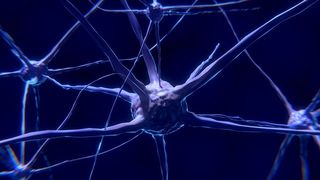Neuroscience
New Discoveries About Myelin That Have Changed Neuroscience
New research suggests myelin is much more active than previously thought.
Posted November 17, 2019 Reviewed by Devon Frye
Neurons are the basic functional units of the brain. They have three main parts: dendrites, a cell body, and an axon (more commonly known as a nerve fiber).
Dendrites look like twigs growing off the cell body and act like radio antennae, receiving signals from other neurons. The nerve fiber is a single long extension coming off the cell body. Nerve fibers are like telephone wires, connecting distant places all over the country. Nerve fibers connect neurons in different areas of the brain to one another, as well as connect neurons with cells in different parts of the body. Neurons communicate using electricity.

Myelin is a white, fatty substance that wraps itself around nerve fibers.
For centuries, myelin has intrigued the men and women trying to understand the mysteries of the nervous system.
In the late 1800s, it was deemed an insulator—a structure wrapping nerve fibers to keep the electricity within the nerve itself.
Others thought it might be food. Nerves can be several feet in length and are isolated from the cell body. Perhaps myelin is getting broken down and used by the nerve fiber to sustain itself.
In 1939, the real function of myelin was identified: it speeds up neural transmission. Nerve fibers wrapped in myelin can transmit their electric signals much faster. Myelin makes saltatory conduction in nerve fibers possible.
In the brain and spinal cord, myelin is created by cells called oligodendrocytes. These octopus-looking cells have a cell body and several extensions growing off in all directions. Each extension wraps a segment of a nerve fiber like toilet paper being wound around a cardboard tube.
Outside the brain and spinal cord, myelin is created by Schwann cells. Schwann cells look more like a sausage link. One cell is responsible for one segment of myelin.
The segmented nature of myelin means that portions of the nerve fiber are not wrapped. These are called the nodes of Ranvier (named after the scientist who discovered them).
When a nerve fiber is myelinated, the electric signal “jumps” from one node to the next, allowing it to travel much faster. This leapfrogging is called saltatory conduction.
For decades, we were happy with this definition of myelin. We thought of it as a passive structure—essential to brain function, but something like the concrete footing of a house, poured but forgotten once it was in place and dried. Myelination of the human brain begins late in development and is completed in your twenties—or so it was thought.
In the 2000s, whispers of two new functions of myelin began to be heard.
Myelin Helps Us Learn
Studies using functional magnetic resonance imaging (fMRI) got people thinking that perhaps myelin isn't such a passive structure after all.

White matter in the brain consists of bundles of nerve fibers wrapped in myelin that connect different regions to one another. Fredrik Ullén, a professor of cognitive neuroscience at the Karolinska Institutet in Sweden, studied the white matter of professional pianists. He found that white matter connecting multiple parts of the cerebral cortex used when playing music was much more developed in piano players compared to nonmusicians. The more they practiced, the more white matter they had.
In another study, researchers tracking white matter in people learning to juggle noticed a 5 percent increase in the amount of white matter after six weeks of learning the skill. White matter, and maybe even myelin, seemed to be changing as a result of experience. Maybe myelin isn’t such a passive structure after all.
Jonas Frisén, also at the Karolinska Institutet in Sweden, used an ingenious method to show us just how much myelin changes throughout a person’s life. Frisén and his group found a way to carbon date the myelin in a person’s brain.
Carbon is an essential part of life as we know it. It’s in every part of our body. It’s even in our DNA. We get the carbon we need to grow and maintain our bodies by eating things that can take carbon out of the atmosphere—things like plants and animals who have eaten plants.
In 1955, the Soviet Union conducted seven nuclear tests. The tests released a lot of radioactive carbon into the atmosphere. Plants all over Europe took that radioactive carbon out of the atmosphere and animals eating those plants incorporated it into their growing bodies. People born just before 1955 used some to generate myelin in their developing brains.
Studying the brains of people born before 1955 and who died in the 2000s, Frisén was able to infer how much myelin changed during a person’s life based on how much radioactive carbon was left. Based on Frisén’s studies, we now know the myelin landscape of the brain is constantly changing.
Bill Richardson, a professor at Wolfson Institute for Biomedical Research at University College London, showed us just how integral myelin is to skill learning.
Richardson studied mice learning to run on a wheel with unevenly spaced rungs. Successfully navigating the wheel required mice to learn to fine-tune their coordination. He compared two groups. The first group (the control group) were normal mice. The second group (the experimental group) had a genetic inability to generate myelin. The second group was unable to learn how to run on the wheel.
Studies like these suggest myelin is far from a passive brain structure. It’s active. It’s responding. It’s playing substantial roles in cognitive processes like learning.
The ways in which myelin changes in response to neural activity are called "activity-dependent myelination." Learning how myelin communicates with the nerve fiber to fine-tune the speed of neural transmissions and how this affects neural circuits, learning, and cognition is one of the most active and fascinating areas of myelin research today.
Myelin Keeps Nerve Fibers Alive
Klaus-Armin Nave, a professor of molecular biology and director of the Max Planck Institute in Germany, and Jeffrey Rothstein, a professor of neurology and neuroscience and director of Brain Science Institute in the United States, have each suggested myelin acts as a gateway for the oligodendrocyte to provide nutritional support to the nerve fiber.

Work done since the idea was originally suggested in 2012 is helping us understand how this works.
Neurons need a lot of energy, and nerve fibers can be several feet long. It’s hard to believe that one little neuronal cell body could shoulder the energetic burden all by itself. Indeed, it doesn’t have to.
Oligodendrocytes contribute energy to nerve fibers. When nerve fibers are starving, they signal to oligodendrocytes that they need help. The oligodendrocyte responds by taking up glucose (sugar) from its surroundings, processing it to a molecule called lactate and passing it through channels in myelin to the nerve fiber.
The nerve fiber’s reliance on oligodendrocytes and myelin for sustenance helps us understand why nerve fibers begin to break down when myelin is stripped away. Learning how to protect and repair myelin in normal aging and neurodegenerative diseases like multiple sclerosis, amyotrophic lateral sclerosis, and Alzheimer’s disease could hold the key to preserving brain function in aging and disease.




